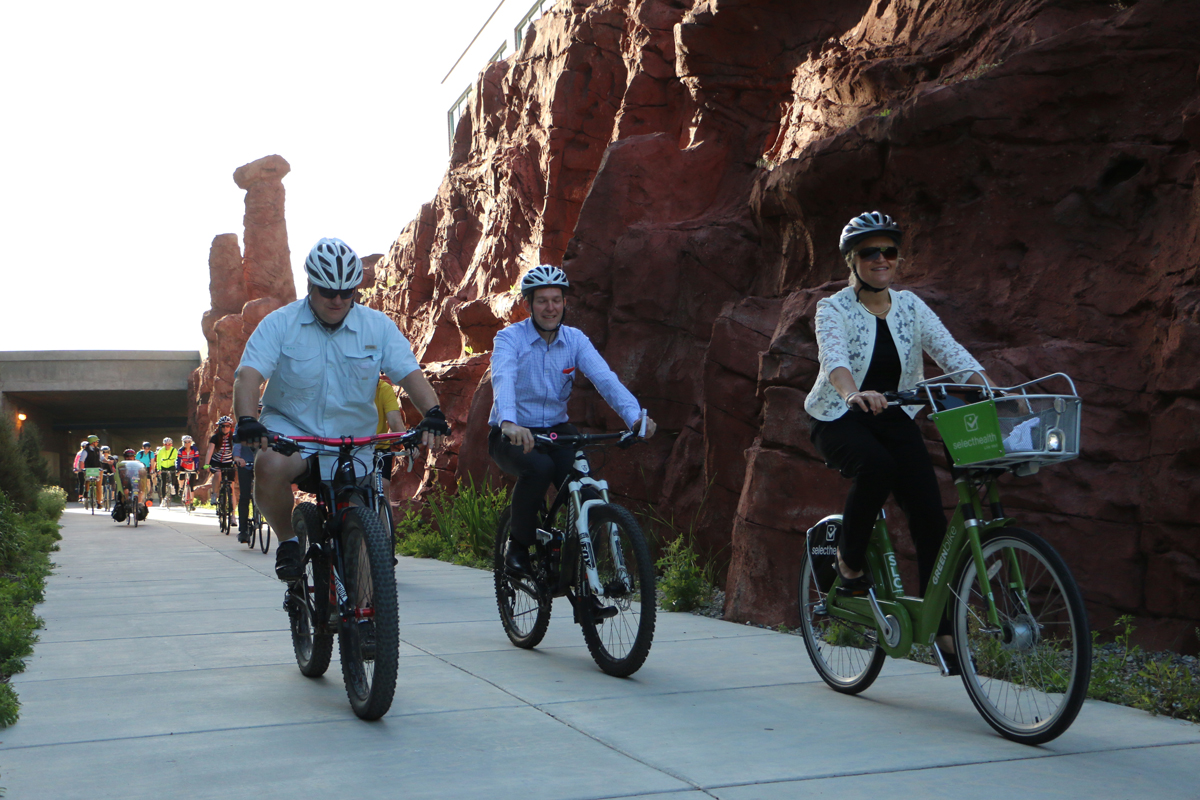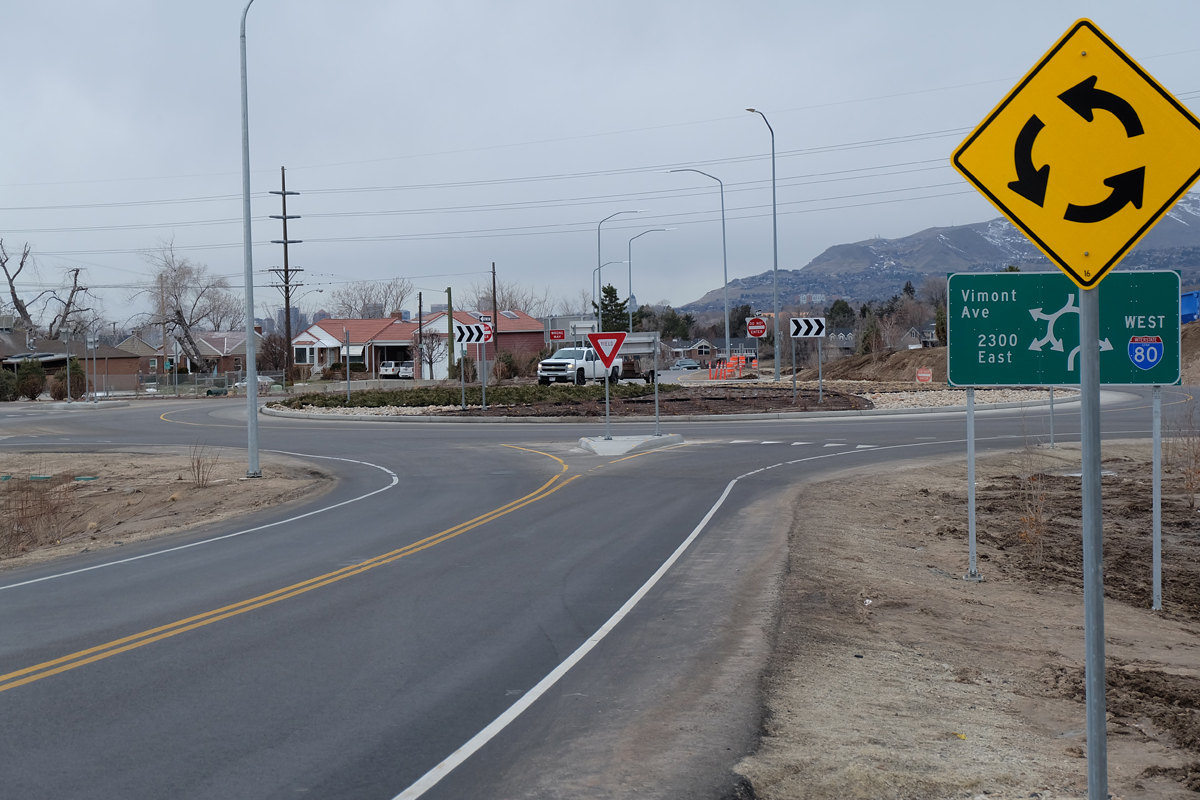By Lou Melini — There are 2 recent upgrades that have improved bike commuting to and from the east Canyon Rim area of the new city of Millcreek, Utah. In case you are not familiar with Canyon Rim, it might be easier for me to say that I live just north of the 3300 South REI store. The first upgrade, the Sugarhouse “S” line bike trail, has been in existence for a few years. This has been a major change on how I travel to and from Salt Lake City. The second upgrade, the rebuilding of 2300 East south of I-80 that includes a roundabout, was dedicated in November 2016. The roundabout has made crossing 2300 East by bike much easier.

The Sugarhouse “S” Line
Up until the past couple of years, 2700 South was my primary commuting road to visit my grandson who lives just south of the “S” line between 6th and 7th East. With the opening of the “S” line bikeway, the 1300 East tunnel and the pathway through Sugarhouse Park; riding on 2700 South has become a rare event. During winter snowstorms, the changes that I just mentioned have made my commute so nice that I am sure that drivers of automobiles are envious.
The pathway through Sugarhouse Park is relatively flat. Then there is the tunnel under 13th East on the west side of the park allowing a very convenient crossing of 13th East. In the winter of 2016-2017, the Sugarhouse trail was frequently plowed of snow. Under the blanket of snow is ice, but the good news is that when the sun was out, the ice would melt quicker without the blanket of snow. I increased the size of my commuter tires to 2.35 and ran them at 20-25 psi. This allowed me to traverse the ice at near normal commuting speeds. This may not sound very positive, but it beats dodging snow piles in the street, parked cars in the bike lane surrounded by snow, potholes and the occasional impatient driver on 2700 South.
Once past the tunnel the asphalt bikeway becomes a wide concrete sidewalk through Hidden Hollow. This is a short but bucolic ride until you hit the parking lot for Whole Foods. The sidewalk west of the little wooden bridge in Hidden Hollow is usually cleared of snow. The section between the tunnel and east of the little wooden bridge was not maintained until a week after the holiday storms. I had to walk through this section a couple of times, as the snow was difficult to ride through during that time period. Since that time maintenance on this small section has been spotty, especially just west of the tunnel.
Riding through the small section of Whole Foods parking lot and Wilmington Ave. in Sugarhouse, one needs to pay attention to the numerous cars making turns. After crossing 11th East, I cut through the Zion’s Bank parking lot to get on the start of the “S” line bikeway just before McClelland Ave (1050 East). From there I am off to my grandson’s house or to my volunteer position at the Salt Lake Bike Collective with little interaction with traffic. I could go a bit faster if I took 2700 South, but the ambiance of the trail makes up for any gain in speed on the road. The bikeway is narrow where the train stations are located so slowing down at these locations will occur as well as slowing due to the presence of pedestrians. There are also numerous street crossings, most of which have pedestrian buttons and stop lights to stop car traffic. I have found that I only need to push the buttons at 9th and 7th East and at State Street as the lack of traffic negates the need to push the signal button at the other crossings. Another word of caution is the numerous driveways and a few streets with stop or yield signs. On occasion I have seen these signs ignored, so be alert and don’t assume you will be given the right-of-way. The final word of caution is to be conscious of cars making a right-turn-on-red at Sugarmont Ave. onto 9th East.
One of the biggest surprises that I encountered on the bikeway is that it is maintained year-round! Snow is removed and salt is put on areas with ice. On one day after a snowstorm the streets appeared to have not seen a snowplow, but the “S” line was clear save for a few isolated patches of snow. In warmer months, broken glass and other trash are quickly cleared. I can only assume that this care is done for the customers of the Sugarhouse rail line so I am expecting that this level of service will continue.
My only complaint about the “S” line bikeway is that it is too short. From McClelland to State St. it is a gem that is well used by numerous people. Though well used, I do not find it hampering my commute except for the occasional person that has headphones listening to whatever in the middle of the bikeway and unaware of my attempts to get his/her attention.
When first opened, there was a goathead (puncture vine) problem between Main and State Street that spread to 2nd East. I picked up quite a few when pushing my grandson in a stroller. I have not had a thorn in any tire (bike or otherwise) since 2014, perhaps 2013.
In conclusion, if you live, work, or find yourself needing to be in the Sugarhouse area, you should consider using the “S” line bikeway. It will be well worth the slower ride.

2300 East Upgrades:
Prior to 2016, 2300 was a street that I crossed frequently but did not ride on. I crossed at either Atkin Ave (2800 South) or the next street to the north, Claybourne Ave. Neither was ideal, but it was manageable. In 2016, it was to change.
Julie and I were gone for 6 months hiking the Appalachian Trail, so we were able to miss all of the construction and orange cones on 2300 East from I-80 to 3900 while it was being rebuilt. Shortly after our arrival home, we were able to experience a new street with bike lanes and a roundabout at the north end. I was a bit anxious that the new road was being oversold for its bike and pedestrian friendly upgrades.
Unfortunately crossing at Atkin and Claybourne Avenues have not changed. Neither is any easier to cross than before. The pedestrian light at Claybourne is the same light as before. The roundabout however has been wonderful and easy to maneuver across.
The benefits of the roundabout are three-fold. First I have 2-single lanes to cross vs. the 3 lanes, that includes the left turn lane, at Claybourne. Secondly there are large, prominently placed yield signs have been erected to alert drivers to yield to traffic within the roundabout. I have had 100% of the drivers yield to me when I am in the circle, even drivers coming off of I-80. At Claybourne, I had about an 80-90% rate of cars stopping when I was crossing, even with the pedestrian light flashing. Perhaps it has since been better, but with the roundabout so easy to cross, I haven’t had a desire to cross at Claybourne. And finally the speed of the cars is a very pedestrian 20 MPH within the roundabout. Even my lead-footed wife drives at that speed within the roundabout. At Claybourne, cars are accelerating off of the roundabout from the north and seem to be at the posted speed limit of 35 coming from the south.
There is a fourth benefit to the roundabout in the winter. Neither Claybourne nor Atkin receive a lot of sun and minimal snowplows, so riding those roads can be a bit icy and dicey. The roundabout is in the sun and is kept clean due to snowplows and the number of cars.
I have heard comments that being on a bike in a roundabout is not a comfortable place to be. This may be true of some roundabouts but at the north end of 2300 East is quite pleasant to navigate. I would recommend that you try it as you pass through Canyon Rim.
If you are still not sure about riding in a roundabout there will be a new bike pathway taking you across 2300 East to 1700 East near Sugarhouse park. A bridge will take you over the off-ramp and a tunnel will take you under the on-ramp just north of the new roundabout. Completion is expected in August.
Editor’s Note: The bicycle commuter column since 2004 has featured individuals that bike commute. With this column I hope to expand the commuter column to include other aspects of bike commuting. The column will continue to include individuals with expansion to include bike routes, commuter bikes and other aspects that will make the column educational and entertaining for the utilitarian use of bicycles. Contact Lou Melini at [email protected] if you have an individual or topic for the column.

